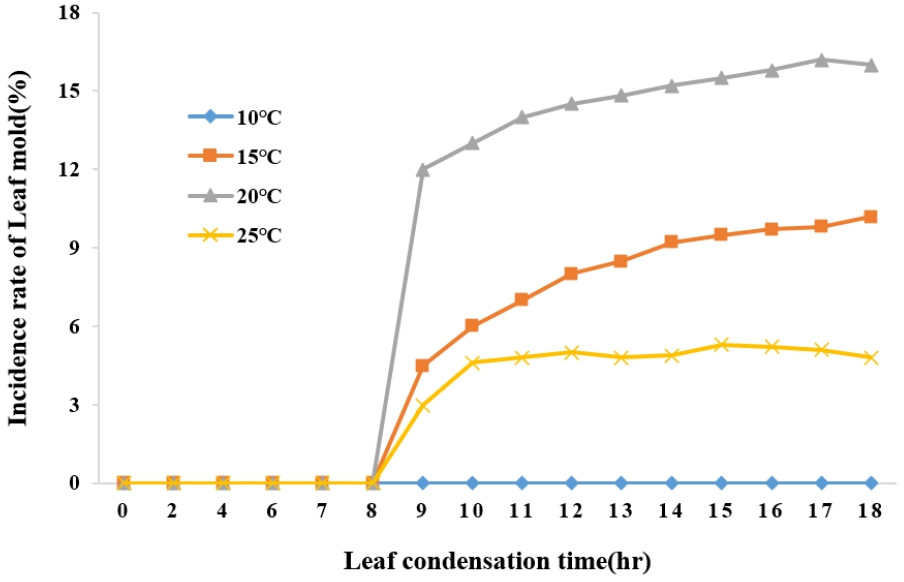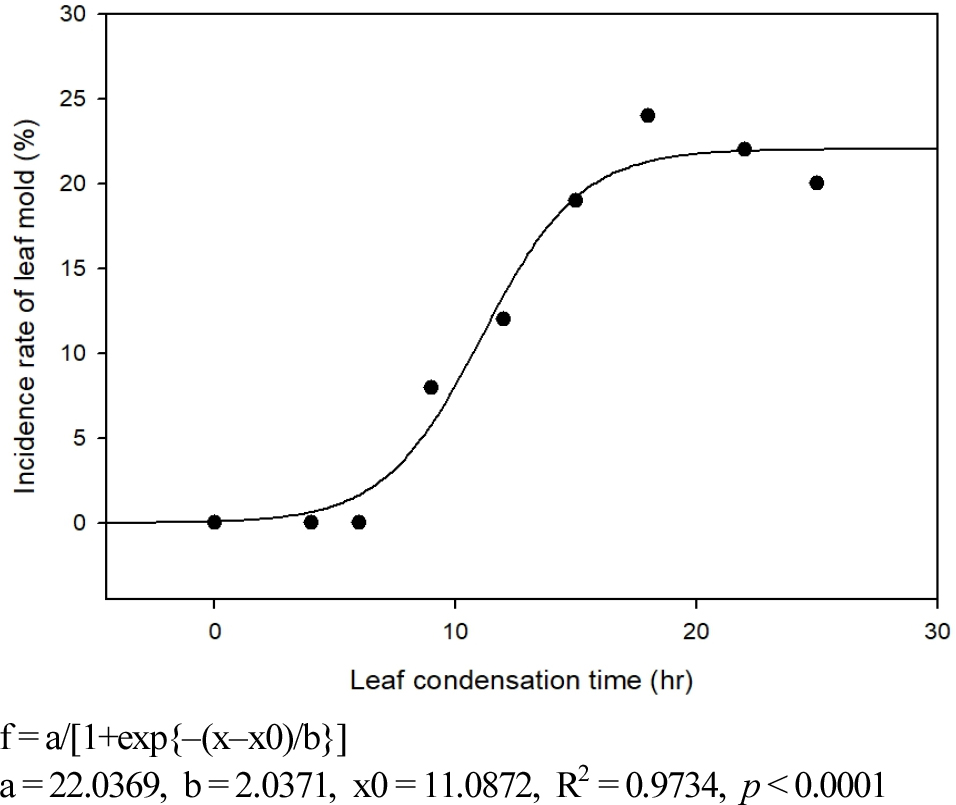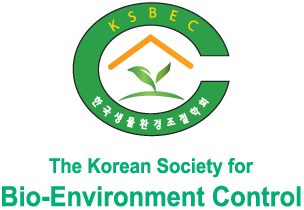Introduction
Materials and Methods
1. Study for prediction model of leaf mold in tomato
2. Study of leaf mold and gray leaf spot management modeling
Results
1. Development of leaf mold prediction model
2. Study of leaf mold and gray spot mold management modeling
Discussion
Conclusion
Introduction
Greenhouse vegetable production (GVP) has risen fast and has become a significant area of vegetable production as a result of rising vegetable consumption and economic benefits for vegetable growers (Xu et al., 2015). Pesticides are regarded as an essential component of contemporary farming, playing a significant role in sustaining high agricultural output (Jallow et al., 2017). Tomato gray leaf spot is a significant tomato disease that affects the plant's leaves, resulting in massive output losses and harvest delays (Wang et al., 2020). Similarly, gray leaf spot of tomato is a global disease, and its increasing incidence in greenhouses has increased the gravity of epidemic hazard in some tomato cultivating regions. Because this is a relatively new disease, farmers frequently lack experience in prevention and control, resulting in significant production losses (Liu and Wang, 2020).
Most pest control methods based on management models recommend spraying pesticide at seven to ten day intervals from the date of planting until harvest, but this method may result in pesticide waste because pesticide spraying is often done regardless of weather conditions or the scale of the target disease incidence. Notably, in greenhouse growing conditions, such as those found in Korea, where production is less impacted by external factors, this strategy may be deemed wasteful. Another technique is to employ a forecasting model to anticipate illness incidence. To prevent early blight caused by Alternaria solani, the Forecast System for Alternaria Solani in Tomato (FAST) model was developed, and TOMCAST is a prediction model derived from FAST that is effective in preventing early blight (by Alternaria solani), septoria leaf spot (by Septoria lycopersici), and anthracnose fruit rot (by Colletotrichum coccodes) (Pitblado, 1988, 1992). When compared to traditional pest control without model predictions, these prediction models were found to lower the number of pesticide spraying cycles(MacNab and Gardner, 1993; Sikora et al., 1994; Gleason et al., 1995).
In Korea, research on plant disease prediction models began in 1947 with an inquiry by the Central Agricultural Institute of Technology's Basic Research Department into the scattering status of hyphomycetes and Cochliobolus miyabeanus conidia (Anonymous, 1947).
Aboveground fungal diseases known to occur in tomato include leaf mold (Fulvia fulva), powdery mold, grey mold (Botrytis cinerea), early blight, black leaf mold (Pseudocercospora fuligena), and late blight (Phytophthora infestance) (Korean Society of Plant Pathology, 2009). A model to forecast the development of late blight was established in Korea by improving the moving graph approach currently used in potato farming in the United States to reflect monthly average temperatures, 7-day cumulative precipitation, relative humidity, and 7-day average lowest temperatures. In addition, based on the discovery that the duration of leaf wetness is closely related to the occurrence of late blight, a dew condensation model applicable to potato crops was developed using relative humidity, temperature, and wind speed data, and it was then used to develop a plant disease prediction model (Hahm et al., 1978; Hwang et al., 1996). Meanwhile, Ahn et al. (1998a, 1998b) developed a moving average model capable of forecasting disease onset based on daytime average temperatures and the number of days with high humidity, proving that the progressive model of late blight suited a logit model.
Unlike in the United States, most tomatoes in Korea are cultivated in greenhouses, thus the impacts of precipitation or wind speed are insignificant. Temperature and humidity may also be changed. As a result, the current study proposes to construct a prediction model that would allow crop growers to avoid illness from occurring in the first place, for example, by managing heating equipment or opening roof windows so that humidity may be correctly regulated in a timely way. When condensation forms on the leaves, the proposed model will aid in the establishment and provision of an appropriate pesticide spraying schedule to boost tomato production.
Materials and Methods
1. Study for prediction model of leaf mold in tomato
1.1 Species and seedlings
Cherry tomato ‘Summer King’ (Vegetable Research Center, cherry tomato) was planted in a 40-hole connection port gardening bed soil (nursery soil), and tomato seedlings with five to six foliage leaves were tested.
1.2 Strains and inoculation methods
Fulvia fulva and Stemphylium lycopersici were isolated from tomatoes cultivated in Buyeo, Chungcheongnam-do, Korea, and isolated monospore on a Potato dextrose agar (PDA) medium containing streptomycin. Following that, the isolated strain was injected into the V8 medium and exposed to UV light for 30 minutes every two hours for 20 days to enhance spore development. A hemocytometer connected to an optical microscope was used to assess spore concentration. Sterile water was added to dilute the solution, yielding a spore suspension with a concentration of 1 × 104 mL-1. The tomato seedlings growing in the 40-hole connection port were sprayed with 40 cc of spore solution. It was assured that all of their leaves were suitably saturated prior to the inoculation process.
1.3 Condensation on leaves and treatment temperatures
At 10, 15, 20, 25, and 30°C for time periods ranging from 0 to 24 hours, tomato seedlings injected with the spore solution were assumed to be in a condensation condition while remaining in a wet phase.
1.4 On-farm investigation of occurrence of leaf mold
The research was carried out on 10 farms in Buyeo and Nonsan, Chungcheongnam-do, Korea. Watchdog 1450 (Spectrum Tech., USA) was used to measure temperature and condensation time, while leaf wetness was used to detect leaf wetness (Spectrum Tech., USA).
2. Study of leaf mold and gray leaf spot management modeling
All of the growth conditions and strain inoculation procedures employed in the prediction model investigation were the same. The infected tomato seedlings, on the other hand, were treated in a dew chamber at 20°C for 12 hours before being transferred to a 20°C incubator.
2.1 Leaf mold treatment of chemical agents
To attain the goal concentration, 30 percent trimidazole, 50 percent polyoxin B, and 40 percent iminoctadine tris (Belkut) were diluted 1,000 times and administered to tomato plants between zero and 240 hours following spore inoculation. A control set of untreated seedlings was also created for comparison.
2.2 Gray leaf mold treatment of chemical agents
(10% of etridiazole 30% concentratiom) + [55% of thiophanate-methyl(Gajiran)], and 15% of tribasic copper sulfate (Sebinna) were diluted 1,000 times to obtain the required concentration and sprayed to tomato seedlings between zero and 240 hours following spore inoculation. A control set of untreated seedlings was also created for comparison.
2.3 Investigation of occurrence of leaf mold and gray leaf spot statistics analysis
The research was carried out 20 days following the inoculation, and the incidence rate was calculated by comparing it to the control group, which did not receive the spore solution. To analyze and show the experimental data, Sigmaplot was used as statistics software.
Results
1. Development of leaf mold prediction model
The test tomato seedlings were inoculated with a spore solution of Fulvia fulva and Stemphylium lycopersici at a concentration of 1 × 104 conidia·mL-1 and then exposed to a wet phase condensation procedure at 10-25℃ for the time period ranging from 0 to 18 hours. From 5th to 20th after inoculation, leaf mold began to appear when the condensation time surpassed nine hours, and the optimum temperature for the incidence was discovered to be 15-20℃. The disease did not occur at 10℃, and even at 25℃, the incidence rate remained modest, i.e. 4% even when the condensation duration surpassed 16 hours (Fig. 1). Given that the leaf condensation time and temperature are the most important factors determining the occurrence of leaf mold, and that the optimum temperature for tomato cultivation is 15-25°C, adjusting the leaf condensation time rather than the temperature is thought to be more effective in preventing leaf mold. Gray leaf spot development began 9 hours after leaf wet, and disease incidence temperature of 20-25°C was greater than temperature parameters for general fungal illness. There was no occurrence at 10°C, and the 12% incidence was greatest 12 hours after leaf moist at 25°C. At 30°C, the incidence was decreased (Fig. 2). Therefore, the ideal temperature for gray leaf spot disease growth was thought to be approximately 25°C. The most essential elements creating gray leaf spot are the hour of leaf wetness and the temperature. Because the growing temperature of tomato plants ranges from 5 to 25°C, it was difficult to manage the temperature for the suppression of gray leaf spot (Bierhuizen and Wagenvoort, 1977). So, it has been proposed to reduce the occurrence of gray leaf spot by managing the period of leaf wetness.

Fig. 2.
Incidence rate of gray leaf spot according to leaf condensation time and temperature. Gray leaf spot disease began to appear when leaf condensation time lasted over 9 hours. Incidence rate of gray leaf spot was the highest at 15℃. It tended to increase gradually with longer condensation times.
Given the facts above, it is advised that when condensation on leaves develops in a greenhouse, the temperature be raised using a boiler and the humidity be reduced by opening upside or roof windows. These simple procedures are thought to be enough for preventing the formation of leaf mold and gray leaf spot. Meanwhile, tomato seedlings injected with leaf mold and gray spot mold spores were observed, and the incidence rate of leaf mold was calculated based on temperature. Because the first incident occurred 14 days after the injection, the latency period is expected to be 14 to 15 days (Table 1 and 2).
Table 1.
Comparison of incidence of leaf mold according to latency period and temperature.
| Temp. (℃) | Latency period (day) | ||||||||||||
| 6 | 7 | 8 | 9 | 10 | 11 | 12 | 13 | 14 | 15 | 16 | 17 | 18 | |
| 10 | 0z | 0 | 0 | 0 | 0 | 0 | 0 | 0 | 0 | 0 | 0 | 0 | 0 |
| 15 | 0 | 0 | 0 | 0 | 0 | 0 | 0 | 0 | 5 | 7 | 9 | 10 | 11 |
| 20 | 0 | 0 | 0 | 0 | 0 | 0 | 0 | 0 | 9 | 12 | 14 | 15 | 18 |
| 25 | 0 | 0 | 0 | 0 | 0 | 0 | 0 | 0 | 3 | 4 | 5 | 5 | 6 |
Table 2.
Comparison of incidence of gray leaf spot according to latency period and temperature.
| Temp. (℃) | Latency period (day) | ||||||||||
| 8 | 9 | 10 | 11 | 12 | 13 | 14 | 15 | 16 | 17 | 18 | |
| 10 | 0z | 0 | 0 | 0 | 0 | 0 | 0 | 0 | 0 | 0 | 0 |
| 15 | 0 | 0 | 0 | 0 | 0 | 0 | 2 | 10 | 12 | 13 | 19 |
| 20 | 0 | 0 | 0 | 0 | 0 | 0 | 0 | 13 | 17 | 19 | 21 |
| 25 | 0 | 0 | 0 | 0 | 0 | 0 | 0 | 18 | 24 | 27 | 29 |
| 30 | 0 | 0 | 0 | 0 | 0 | 0 | 0 | 12 | 15 | 17 | 19 |
1.1 Incidence rate of leaf mold, condensation time 12 hours
The results of ten farms in Buyeo and Nonsan, Chungcheongnam-do, revealed that the R-squared value between the leaf condensation duration and the incidence rate of leaf mold was very high at 0.98, and the illness did not develop when the condensation period was shorter than seven hours (Fig. 3). These findings are consistent with those obtained by inducing the occurrence of leaf mold utilizing a moist phase (Fig. 1).
2. Study of leaf mold and gray spot mold management modeling
2.1 Leaf mold
The tomato seedlings inoculated with F. fulva spores were treated with chemical agents used to leaf mold in tomato, i.e., trimidazole, polyoxin B, and iminoctadine tris (Belkut). The incidence rate of leaf mold was studied for 20 days after 12 hours of condensation time (Fig. 4). After 144 hours of spore inoculation, trimidazole, polyoxin B, and iminoctadine tris treatment reduced the leaf mold by 98, 88, and 86%, respectively; while treating with these fungicides after 240 hours of inoculation decreased the values to 60, 60, and 65%, respectively. These findings indicate that the duration of treatment is more essential than the type of chemical agent in avoiding leaf mold. It should be mentioned, however, that the latency period of leaf mold is roughly 14 days (as shown in Table 1).
2.2 Gray leaf spot
The tomato seedlings inoculated with S. lycopersici spores were treated with chemical agents applied to gray leaf spot in tomato, i.e., etridiazole+thiophanate-methyl (Gajiran), tribasic copper sulfate (Sebinna). After 12 hours of the condensation time, the incidence rate of gray leaf spot was investigated for 20 days (Fig. 5). Etridiazole + thiophanate-methyl and tribasic copper sulfate treatment after 168 hours of spores inoculation controlled gray leaf spot by 92 and 85%, respectively; while treating with these fungicides after 384 hours of inoculation decreased the values to 50 and 46%, respectively. These observations show that the treatment time is more important than the type of chemical agent in preventing leaf mold. However, it should be noted that the latency period of gray leaf spot is approximately 14 days (as shown in Table 2).
Discussion
The finding of present study concluded that leaf mold and gray leaf spot occurred at ambient temperature with leaf condensation time of eight hours; while the incidence of leaf mold and gray leaf spot incidence was highest at 20 and 25℃, respectively with latency period of 14-15 days at these temperatures. Lee et al. (2017) have been report that Tomato Late blight was occurred on leaf wet over 6hr, but gray leaf spot showed the symptoms on leaf wet conditions over 9hr because the spores of S. lycopersici penetrate into stomata of leaves. Therefore, optimal temperature of disease development of gray leaf spot was considered to be around 25℃. The most important factors causing gray leaf spot understood to be the hour of leaf wet and temperature. There was difficult to control the temperature for suppressing of the incidence of gray leaf spot because the growth temperature of tomato plants is at 5-25℃ (Bierhuizen and Wagenvoort, 1977). So, there has been consider to suppress of the incidence of gray leaf spot by controlling the time of leaf wet.
These findings are consistent with those of Nita et al. (2003), Park et al. (1992) and Lee et al. (2017) who discovered that the incidence rate of zonate leaf spot on strawberries increased with increasing leaf condensation time and that it was possible to estimate the occurrence time of anthracnose and the appropriate time to take pest management measures based on the timing of dew formation on grapes and tomato. Also, the incidence of gray leaf spot was higher when the water was spray on leaves under sprinkler than underground irrigation using dripper (Cabral et al., 2013). As a result, incidence of gray leaf spot estimated to relate the time of leaf wet.
The effectiveness of fungicide is strongly related to the time of application as it fell from ~90% at 144 hours to 65 and 48% at 240 hours. for leaf mold and gray leaf spot, respectively. The 15 days latency period make this disease difficult to control with fungicide application after the incidence. As a result, when leaf mold and gray leaf spot appear on late leaves as a result of disease forecasting, it is required to remove those affected leaves as well as three earlier leaves suspected of being impacted and quickly spray suitable chemical agents to effectively limit the disease. Also, when leaf mold and gray leaf spot incidence observed as a result of disease forecasting, remove 2-3 earlier leaves along with affected leaves contain the spread of disease. Park et al. (1992) found that selecting the timing of pesticide spraying based on the occurrence of condensation on grapes can minimize pesticide treatment to prevent grape anthracnose. Recently, Lee et al. (2017) found that earlier application of fungicides can effectively control the late blight in tomato as was predicted in our study (Fig. 3). The key findings of this study show that by applying pest control strategies based on leaf condensation time, it will be feasible to lower the overall quantity of pesticide needed.
Conclusion
The forecasting model established in this work will assist crop farmers in detecting the circumstances that are conducive to leaf mold and gray leaf mold, allowing them to regulate their greenhouse environment by operating heating devices or opening roof windows and side windows before 8 hours. of leaf condensation time. Fungicide application timing may be done properly for improved disease management. Regardless of the three types of chemicals used for controlling of leaf mold, spraying of the chemical before 150 hours of inoculation showed high control value of 80%, but spraying after 150 hours. it has been declined dramatically. Also, control value of grey leaf mold when three chemicals sprayed before 150 hours. showed 80%, after that it has been sprayed control effect was decreased. R2 value for controlling of two fungal disease on tomato plants were 0.94-0.99, therefore control time and control value showed a very high correlation. All of these procedures, taken collectively, will effectively limit the occurrence of leaf mold, so contributing to the long-term viability of tomato agriculture.








